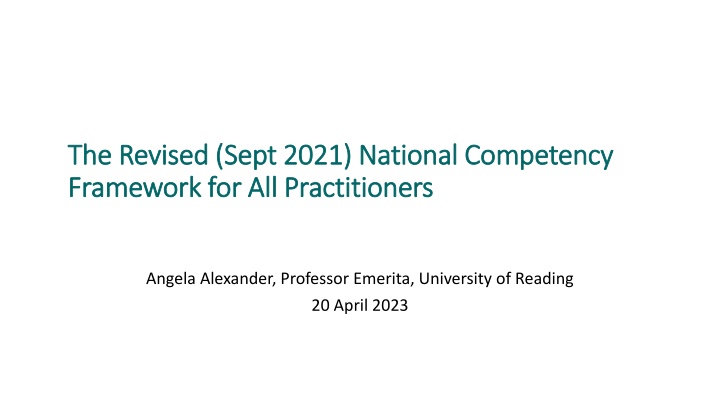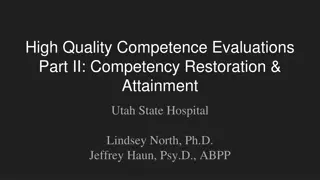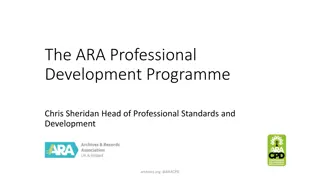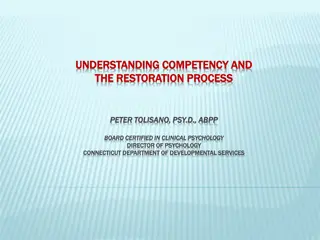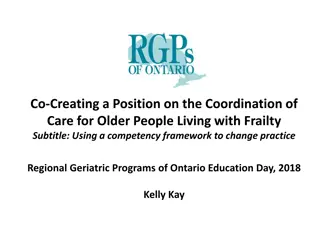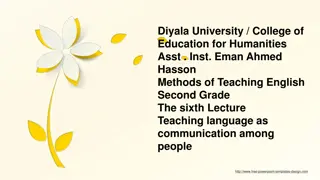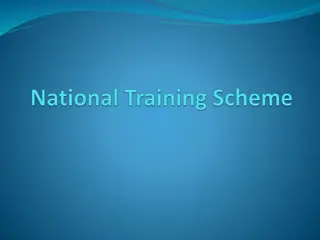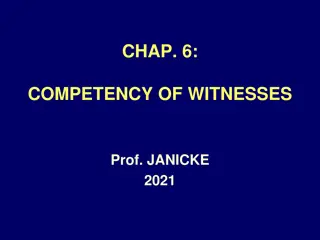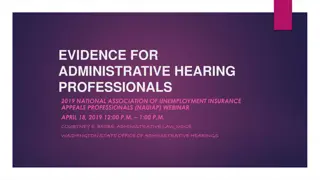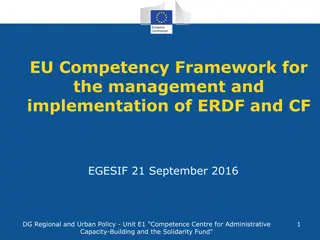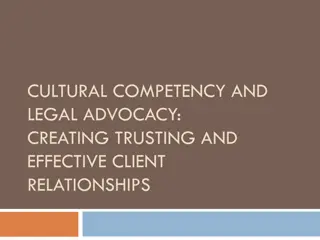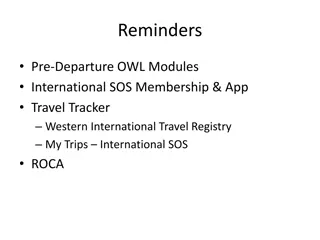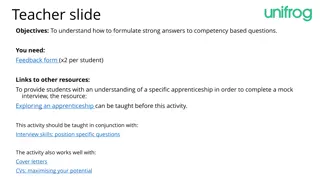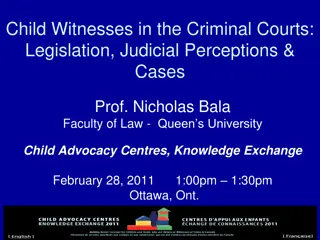National Competency Framework Update September 2021
National Competency Framework has been revised in September 2021 to incorporate legislative changes and new prescribing topics. The update introduces key themes like consultation settings, health literacy, social prescribing, and more, with an emphasis on professionalism and scope of practice. Endorsed by various professional bodies, the framework aims to enhance prescribing practices and support practitioners in delivering quality care.
Download Presentation

Please find below an Image/Link to download the presentation.
The content on the website is provided AS IS for your information and personal use only. It may not be sold, licensed, or shared on other websites without obtaining consent from the author.If you encounter any issues during the download, it is possible that the publisher has removed the file from their server.
You are allowed to download the files provided on this website for personal or commercial use, subject to the condition that they are used lawfully. All files are the property of their respective owners.
The content on the website is provided AS IS for your information and personal use only. It may not be sold, licensed, or shared on other websites without obtaining consent from the author.
E N D
Presentation Transcript
The Revised (Sept 2021) National Competency The Revised (Sept 2021) National Competency Framework for All Practitioners Framework for All Practitioners Angela Alexander, Professor Emerita, University of Reading 20 April 2023
My task (and yours) My task (and yours) the revised framework: what has changed? deadlines for implementation what does good prescribing look like? Competency dimensions how the national framework can be used in practice levels of prescribing competence the competency framework for designated prescribing practitioners moving forward and current issues
So why did we need a revised framework? So why did we need a revised framework? Since the 2016 framework, there have been various changes which needed to be included in the update of the framework these include: Legislation changes introducing paramedic prescribers in April 2018 Current prescribing topics such as remote prescribing, social prescribing, psychosocial assessment and sustainable prescribing Publication of the RPS Competency Framework for Designated Prescribing Practitioners in December 2019
The revised framework: what has changed? The revised framework: what has changed? New key themes were added e.g. consultation setting, health literacy, social prescribing, sustainable prescribing, reducing waste, and supporting others prescribing (DPP) The professionalism section is now integrated into the framework with more focus on scope of practice Now 76 supporting statements 12 new ones New further information sections added to provide clarity and give examples
Endorsed by: Endorsed by: Association For Prescribers British Dental Association British Dietetic Association British Pharmacological Society Chartered Society of Physiotherapy College of Optometrists College of Paramedics Joint Council For Cosmetic Practitioners Pharmaceutical Society of Northern Ireland Royal College Of Midwives Royal College of Nursing Royal College of Podiatry Society of Radiographers Royal College of General Practitioners And not forgetting Patients!
Structure of the framework TWO DOMAINS COMPETENCY AND SUPPORTING STATEMENTS FURTHER INFORMATION 6
1. Assess the patient 1.1 Undertakes the consultation in an appropriate setting. 1.2 Considers patient dignity, capacity, consent and confidentiality. 1.3 Introduces self and prescribing role to the patient/carer and confirms patient/carer identity. 1.4 Assesses the communication needs of the patient/carer and adapts consultation appropriately. 1.5 Demonstrates good consultation skills and builds rapport with the patient/carer. 1.6 Takes and documents an appropriate medical, psychosocial and medication history including allergies and intolerances. 1.7 Undertakes and documents an appropriate clinical assessment. 7
1. Assess the patient 1.8 Identifies and addresses potential vulnerabilities that may be causing the patient/carer to seek treatment. 1.9 Accesses and interprets all available and relevant patient records to ensure knowledge of the patient s management to date. 1.10 Requests and interprets relevant investigations necessary to inform treatment options. 1.11 Makes, confirms or understands, and documents the working or final diagnosis by systematically considering the various possibilities (differential diagnosis). 1.12 Understands the condition(s) being treated, their natural progression, and how to assess their severity, deterioration and anticipated response to treatment. 8
1. Assess the patient 1.13 Reviews adherence (and non-adherence) to, and effectiveness of, current medicines. 1.14 Refers to or seeks guidance from another member of the team, a specialist or appropriate information source when necessary. 9
2. Identify evidence-based treatment options available for clinical decision making 2.1 Considers both non-pharmacological and pharmacological treatment approaches. 2.2 Considers all pharmacological treatment options including optimising doses as well as stopping treatment (appropriate polypharmacy and deprescribing). 2.3 Assesses the risks and benefits to the patient of taking or not taking a medicine or treatment. 2.4 Applies understanding of the pharmacokinetics and pharmacodynamics of medicines, and how these may be altered by individual patient factors. 2.5 Assesses how co-morbidities, existing medicines, allergies, intolerances, contraindications and quality of life impact on management options. 10
2. Identify evidence-based treatment options available for clinical decision making 2.6 Considers any relevant patient factors and their potential impact on the choice and formulation of medicines, and the route of administration. 2.7 Accesses, critically evaluates, and uses reliable and validated sources of information. 2.8 Stays up to date in own area of practice and applies the principles of evidence-based practice. 2.9 Considers the wider perspective including the public health issues related to medicines and their use, and promoting health. 2.10 Understands antimicrobial resistance and the roles of infection prevention, control and antimicrobial stewardship measures. 11
3. Present options and reach a shared decision 3.1 Actively involves and works with the patient/carer to make informed choices and agree a plan that respects the patient s/carer s preferences. 3.2 Considers and respects patient diversity, background, personal values and beliefs about their health, treatment and medicines, supporting the values of equality and inclusivity, and developing cultural competence. 3.3 Explains the material risks and benefits, and rationale behind management options in a way the patient/carer understands, so that they can make an informed choice. 12
3. Present options and reach a shared decision 3.4 Assesses adherence in a non-judgemental way; understands the reasons for non- adherence and how best to support the patient/carer. 3.5 Builds a relationship which encourages appropriate prescribing and not the expectation that a prescription will be supplied. 3.6Explores the patient s/carer s understanding of a consultation and aims for a satisfactory outcome for the patient/carer and prescriber. 13
4. Prescribe 4.1 Prescribes a medicine or device with up-to-date awareness of its actions, indications, dose, contraindications, interactions, cautions and adverse effects. 4.2 Understands the potential for adverse effects and takes steps to recognise, and manage them, whilst minimising risk. 4.3 Understands and uses relevant national, regional and local frameworks for the use of medicines. 4.4 Prescribes generic medicines where practical and safe for the patient, and knows when medicines should be prescribed by branded product. 4.5 Accurately completes and routinely checks calculations relevant to prescribing and practical dosing. 4.6 Prescribes appropriate quantities and at appropriate intervals necessary to reduce the risk of unnecessary waste. 14
4. Prescribe 4.7 Recognises potential misuse of medicines; minimises risk and manages using appropriate processes. 4.8 Uses up-to-date information about the availability, pack sizes, storage conditions, excipients and costs of prescribed medicines. 4.9 Electronically generates and/or writes legible, unambiguous and complete prescriptions which meet legal requirements. 4.10 Effectively uses the systems necessary to prescribe medicines. 4.11 Prescribes unlicensed and off-label medicines where legally permitted, and unlicensed medicines only if satisfied that an alternative licensed medicine would not meet the patient's clinical needs. 4.12 Follows appropriate safeguards if prescribing medicines that are unlicensed, off- label, or outside standard practice. 15
4. Prescribe 4.13 Documents accurate, legible and contemporaneous clinical records. 4.14 Effectively and securely communicates information to other healthcare professionals involved in the patient s care, when sharing or transferring care and prescribing responsibilities, within and across all care settings. 16
5. Provide information 5.1 Assesses health literacy of the patient/carer and adapts appropriately to provide clear, understandable and accessible information. 5.2Checks the patient s/carer s understanding of the discussions had, actions needed and their commitment to the management plan. 5.3 Guides the patient/carer on how to identify reliable sources of information about their condition, medicines and treatment. 5.4 Ensures the patient/carer knows what to do if there are any concerns about the management of their condition, if the condition deteriorates or if there is no improvement in a specific timeframe. 5.5 Encourages and supports the patient/carer to take responsibility for their medicines and self-manage their condition. 17
6. Monitor and review 6.1Establishes and maintains a plan for reviewing the patient s treatment. 6.2 Establishes and maintains a plan to monitor the effectiveness of treatment and potential unwanted effects. 6.3 Adapts the management plan in response to on-going monitoring and review of the patient s condition and preferences. 6.4 Recognises and reports suspected adverse events to medicines and medical devices using appropriate reporting systems. 18
7. Prescribe safely 7.1 Prescribes within own scope of practice, and recognises the limits of own knowledge and skill. 7.2 Knows about common types and causes of medication and prescribing errors, and knows how to minimise their risk. 7.3 Identifies and minimises potential risks associated with prescribing via remote methods. 7.4 Recognises when safe prescribing processes are not in place and acts to minimise risks. 7.5 Keeps up to date with emerging safety concerns related to prescribing. 7.6 Reports near misses and critical incidents, as well as medication and prescribing errors using appropriate reporting systems, whilst regularly reviewing practice to prevent recurrence. 19
8. Prescribe professionally 8.1 Ensures confidence and competence to prescribe are maintained. 8.2 Accepts personal responsibility and accountability for prescribing and clinical decisions, and understands the legal and ethical implications. 8.3 Knows and works within legal and regulatory frameworks affecting prescribing practice. 8.4Makes prescribing decisions based on the needs of patients and not the prescriber s personal views. 8.5 Recognises and responds to factors that might influence prescribing. 8.6 Works within the NHS, organisational, regulatory and other codes of conduct when interacting with the pharmaceutical industry. 20
9. Improve prescribing practice 9.1 Improves by reflecting on own and others prescribing practice, and by acting upon feedback and discussion. 9.2 Acts upon inappropriate or unsafe prescribing practice using appropriate processes. 9.3 Understands and uses available tools to improve prescribing practice. 9.4 Takes responsibility for own learning and continuing professional development relevant to the prescribing role. 9.5 Makes use of networks for support and learning. 9.6 Encourages and supports others with their prescribing practice and continuing professional development. 9.7 Considers the impact of prescribing on sustainability, as well as methods of reducing the carbon footprint and environmental impact of any medicine. 21
9. Further information on the supporting statements a Processes include whistleblowing, regulatory and professional guidance, and employer procedures. b Tools include supervision, observation of practice and clinical assessment skills, portfolios, workplace competency-based assessments, questionnaires, prescribing data analysis, audits, case-based discussions, personal formularies and actively seeking regular patient and peer feedback c By continuously reviewing, reflecting, identifying gaps, planning, acting, applying and evidencing learning or competencies. d By considering mentoring, leadership and workforce development (for example, becoming a Designated Prescribing Practitioner). e Methods of reducing a medicine s carbon footprint and environmental impact include proper disposal of medicine/device/equipment waste, recycling schemes, avoiding overprescribing and waste through regular reviews, deprescribing, dose and device optimisation. 22
10. Prescribe as part of a team 10.1 Works collaboratively as part of a multidisciplinary team to ensure that the transfer and continuity of care (within and across all care settings) is developed and not compromised. 10.2 Establishes relationships with other professionals based on understanding, trust and respect for each other s roles in relation to the patient s care. 10.3 Agrees the appropriate level of support and supervision for their role as a prescriber. 10.4 Provides support and advice to other prescribers or those involved in administration of medicines where appropriate. 23
Deadlines for implementation Deadlines for implementation Publication date: September 2021 Effective date: by September 2022 Next review date: September 2026
What does good prescribing look like? What does good prescribing look like? (and who is best to ask?) (and who is best to ask?)
How the national framework can be used in How the national framework can be used in practice practice Attending networking/learning events Audits Case studies Case-based discussions CPD records Looking at prescribing data analysis Observation of practice and clinical assessment skills Peer discussions & feedback Personal formularies Portfolios mapped to competencies Questionnaires and patient feedback. Reading articles, SOPs, guidelines, processes in practice Real life practice examples Reflective accounts - identifying gaps Setting SMART objectives Supervision Video recordings (consent) Workplace competency-based assessments
Levels of prescribing competence Levels of prescribing competence Where is your confidence in all of this too? The framework should help to boost your confidence in prescribing too.
The competency framework The competency framework for Designated Prescribing for Designated Prescribing Practitioners Practitioners regulatory changes in 2018/19 enabled non-medical prescribers (NMPs) to take on role of supervising and confirming competence during the period of learning in practice, in addition to Designated Medical Practitioners (DMPs) there was a need to ensure that those who took on the role were suitable framework was developed with representatives from all prescribers, regulators, education providers and patients.
Structure of the DPP Structure of the DPP competence framework competence framework
Moving forward and current issues Moving forward and current issues Go to https://www.rpharms.com/resources/frameworks/prescribers- competency-framework and https://www.rpharms.com/resources/frameworks/designated- prescribing-practitioner-competency-framework Identify your gaps in relation to your own practice and current and future issues e.g. different consultation models, extending scope of practice If you are expanding your scope of practice have a look at https://www.rpharms.com/about-us/news/details/new-national- guidance-for-expanding-scope-of-prescribing-practice-
Supports prescribers to identify any developmental needs highlight ways in which these needs can be met offer guidance on how to document the process and outcome A number of case studies across a range of professions and settings are provided to illustrate the process.
Any questions
Small group breakout sessions What competencies do you need to develop for the future? Have you or will you be changing your scope of practice in the next few months? What helped you with that change?
